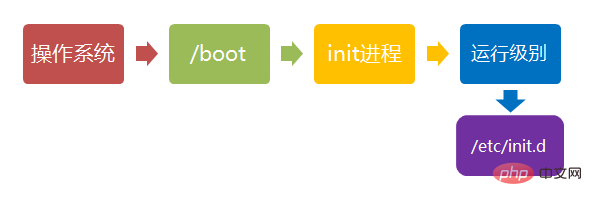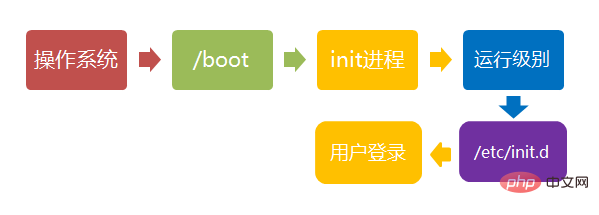
Five stages of the system startup process: 1. Kernel boot stage; when the computer is powered on, it first performs a BIOS power-on self-test and starts according to the startup device (usually a hard disk) set in the BIOS. 2. Run the init phase; the init process is the starting point of all processes in the system. Without this process, no process in the system will start. 3. System initialization phase; call rc to complete some system initialization work. 4. Establish the terminal stage. 5. User logs into the system.

#The operating environment of this tutorial: linux7.3 system, Dell G3 computer.
The startup process of the Linux system is not as complicated as everyone thinks. The process can be divided into 5 stages:
(1) Kernel boot.
(2) Run init.
(3) System initialization.
(4) Create a terminal.
(5) User logs in to the system.
1. Kernel boot
When the computer is powered on, the first step is the BIOS power-on self-test. According to the boot device set in the BIOS (usually is the hard disk) to boot. After the operating system takes over the hardware, it first reads the kernel file in the /boot directory.

2. Run init
(1) The init process is the starting point of all processes in the system. You It can be compared to the ancestor of all processes in the system. Without this process, no process in the system will start. The init program first needs to read the configuration file /etc/inittab.

(2) Run level: Many programs need to be started at boot. They are called "services" in Windows and "daemons" in Linux.
A major task of the init process is to run these programs that are started at boot. However, different programs need to be started in different situations. For example, when used as a server, Apache needs to be started, but when used as a desktop, it is not necessary.
Linux allows different boot programs to be allocated for different occasions, which is called "runlevel". That is to say, based on the "run level" at startup, which programs are determined to be run.

(3) The Linux system has 7 runlevels (runlevels):
3. System initialization
There is such a line in the init configuration file: si::sysinit:/etc/rc.d/rc.sysinitIt /etc/rc.d/rc.sysinit is called and executed, and rc.sysinit is a bash shell script. It mainly completes some system initialization work. rc.sysinit is an important script that must be run first at every run level. .
The main tasks it completes are: activating the swap partition, checking the disk, loading hardware modules and other tasks that need to be performed first.

4. Establish a terminal:
After rc is executed, return to init. At this time, the basic system environment has been set up and various daemon processes have been started. init will then open 6 terminals so that users can log in to the system.
5. User login system:
3 types: command line login, ssh login, and graphical interface login

For details, please see this blog: http://www.ruanyifeng.com/blog/2013/08/linux_boot_process.html
1 . The correct shutdown process is: sync > shutdown > reboot > halt
2. The shutdown command is: shutdown. You can use man shutdown to read the help document.
3. Example:
sync # 将数据由内存同步到硬盘中。 shutdown –h 10 ‘This server will shutdown after 10 mins’ #这个命令告诉大家,计算机将在10分钟后关机,并且会显示在登陆用户的当前屏幕中。 shutdown –h now # 立马关机 shutdown –h 20:25 # 系统会在今天20:25关机 shutdown –h +10 # 十分钟后关机 shutdown –r now #系统立马重启 shutdown –r +10 #系统十分钟后重启 reboot # 就是重启,等同于 shutdown –r now halt # 关闭系统,等同于shutdown –h now 和 poweroff
4、不管是重启系统,还是关闭系统,首先要运行 sync 命令,把内存中的数据写到磁盘中。
关机的命令有 shutdown –h now、halt、poweroff 和 init 0,重启系统的命令有 shutdown –r now、reboot、init 6。
5、shutdown 会给系统计划一个时间关机,它可以被用于停止、关机、重启机器。
shutdown -p now # 关闭机器 shutdown -H now # 停止机器 shutdown -r 09:35 # 在 09:35am 重启机器
要取消即将进行的关机,只要输入下面的命令:
shutdown -c
6、halt 命令通知硬件来停止所有的 CPU 功能,但是仍然保持通电。你可以用它使系统处于低层维护状态。注意在有些情况会它会完全关闭系统。
# halt ### 停止机器 # halt -p ### 关闭机器、关闭电源 # halt --reboot ### 重启机器
poweroff 会发送一个 ACPI 信号来通知系统关机。
# poweroff ### 关闭机器、关闭电源 # poweroff --halt ### 停止机器 # poweroff --reboot ### 重启机器
reboot 命令 reboot 通知系统重启。
# reboot ### 重启机器 # reboot --halt ### 停止机器 # reboot -p ### 关闭机器
相关推荐:《Linux视频教程》
The above is the detailed content of What are the 5 stages of the Linux system startup process?. For more information, please follow other related articles on the PHP Chinese website!